A) I
B) II
C) III
D) IV
E) II and III
Correct Answer

verified
Correct Answer
verified
Multiple Choice
Which of the following statements is (are) true of SN1 reactions of alkyl halides in general?
A) The rate of an SN1 reaction depends on the concentration of the alkyl halide.
B) The rate of an SN1 reaction depends on the concentration of the nucleophile.
C) SN1 reactions of alkyl halides are favoured by polar solvents.
D) Answers a) and c) only are true.
E) Answers a, b, and c are true.
Correct Answer

verified
Correct Answer
verified
Multiple Choice
Which of the following is a nucleophile?
A) hexane
B) cyclohexane
C) 1-chlorohexane
D) cyclohexene
E) none of the above
Correct Answer

verified
Correct Answer
verified
Multiple Choice
Which compound would be the major product? 
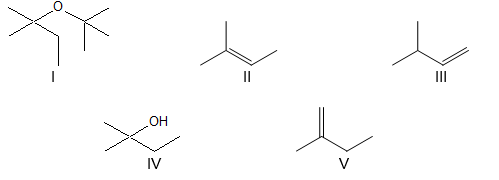
A) I
B) II
C) III
D) IV
E) V
Correct Answer

verified
Correct Answer
verified
Multiple Choice
Which product (or products) would be formed in appreciable amount(s) when trans-1-bromo-2-methylcyclohexane undergoes dehydrohalogenation upon treatment with sodium ethoxide in ethanol? 
A) I
B) II
C) III
D) IV
E) I and II
Correct Answer

verified
Correct Answer
verified
Multiple Choice
Treating 1-methylcyclohexene with HCl would yield primarily which of these? 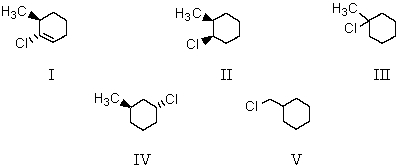
A) I
B) II
C) III
D) IV
E) V
Correct Answer

verified
Correct Answer
verified
Multiple Choice
Which of the following is an electrophile?
A) H2O
B) CH3O-
C) NH3
D) NH4+
E) All are nucleophiles.
Correct Answer

verified
Correct Answer
verified
Multiple Choice
Consider the SN2 reaction of 2-iodopentane with CH3CO2- ion.  Assuming no other changes, what effect on the rate would result from simultaneously doubling the concentrations of both 2-iodopentane and CH3CO2- ion?
Assuming no other changes, what effect on the rate would result from simultaneously doubling the concentrations of both 2-iodopentane and CH3CO2- ion?
A) no effect
B) double the rate
C) triple the rate
D) rate would increase by four times
E) rate would increase by six times
Correct Answer

verified
Correct Answer
verified
Multiple Choice
Which of these is NOT formed when cyclopentene reacts with an aqueous solution of bromine? 
A) I
B) II
C) III
D) IV
E) V
Correct Answer

verified
Correct Answer
verified
Short Answer
Reagents that seek to react with a proton or some other electron-deficient centre are called ______.
Correct Answer

verified
Correct Answer
verified
Multiple Choice
What would be the major product of the following reaction? 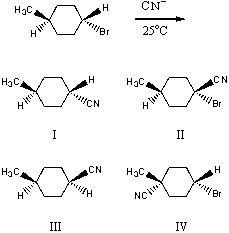
A) I
B) II
C) III
D) IV
E) equimolar amounts of I and III
Correct Answer

verified
Correct Answer
verified
Short Answer
bonds often react with electron-seeking reagents, also referred to as ______.
Correct Answer

verified
Correct Answer
verified
Multiple Choice
Which compound listed below would you expect to be the major product when 2-bromo-2-methylbutane is refluxed with KOH/ethanol?
I  II
II  III
III  IV
IV  V
V 
A) I
B) II
C) III
D) IV
E) V
Correct Answer

verified
Correct Answer
verified
Multiple Choice
What product(s) would you expect to obtain from the following SN2 reaction? 
A) I
B) II
C) equimolar mixture of I and II
D) III
E) mixture of II and III
Correct Answer

verified
Correct Answer
verified
Multiple Choice
Select the rate law for the following reaction, e.g., CH3CH2CH2CHBrCH3 + OH- CH3CH2CH2CHOHCH3 + X-(RBr)
A) Rate = k [RBr]
B) Rate = k [RBr] [OH-]
C) Rate = k [RBr]2 [OH-]
D) Rate = k [RBr] [OH-]2
E) Rate = k [RBr]2 [OH-]2
Correct Answer

verified
Correct Answer
verified
Essay
Predict the products from E2 and E1 reactions. Write and explain the mechanisms of E2 and E1 reactions.
Correct Answer

verified
Elimination reactions convert a single b...View Answer
Show Answer
Correct Answer
verified
View Answer
Multiple Choice
The major product(s) of the following reaction is (are) 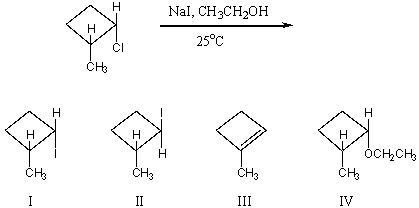
A) I
B) II
C) III
D) IV
E) equimolar mixture of I and II
Correct Answer

verified
Correct Answer
verified
Multiple Choice
Addition of hydrogen chloride to the following molecule would produce 
A) I and II
B) II and III
C) I and IV
D) V
E) II
Correct Answer

verified
Correct Answer
verified
Multiple Choice
Ambident nucleophiles are ones which can react with a substrate at either of two nucleophilic sites. Which of the following is NOT an ambident nucleophile? 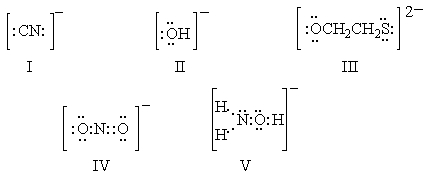
A) I
B) II
C) III
D) IV
E) V
Correct Answer

verified
Correct Answer
verified
Multiple Choice
Which of the following does not contain a nucleophile?
A) propanol
B) propane
C) n-propylamide
D) propene
E) propoxide ion
Correct Answer

verified
Correct Answer
verified
Showing 21 - 40 of 40
Related Exams